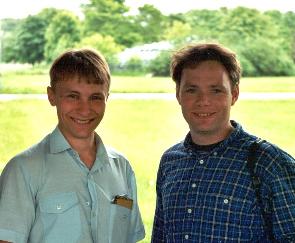"Gamma-Gate - a Stationary System for Gamma-Active
Materials Detection" |
These were our investigations held at JINR (Dubna, Russia) for the CETTO GmbH Company (Ratingen, Germany) led by the research department of the "British Steel" Corporation. The contract terms were to evaluate a plastic scintillation detector for several industrial applications. One of them was a metal scrap monitoring at the utilization factory. The recycling metal may have a remnant activity or, by accident, contain a radioactive source. The transport unit, carrying dangerous wastes, must be detected online and excluded from the whole delivery. Usage of organic crystals was an optimal solution: "size vs. price" to cover the maximum area to be controlled. A number of negative factors reduced the detector performance:
- Large detector volume causes high background rate;
- A rapidly driven vehicle (5...30) km/h. makes the measurement time shorter;
- The radiation scatters off the light and isotropic metal scrap.
These and some other reasons resulted in a coarse detector
sensitivity. In the classical approach a simple count rate
is measured within a certain interval of time. This principle
isn't robust against dummy alarms when the background conditions
aren't stable. For instance, the background rate drops and then
rises up again, when the truck traverses the detector's aperture.
This is a so-called "screening" effect which is usually solved by
setting up higher trigger threshold.
There were some innovative improvements offered by
Dr. V.Kuznetsov and G.Mishinsky to obtain better resolution.
It is a good task for spectrometry to distinguish clearly the
gamma-source. In order to obtain reasonable statistics for
the photo-peak and to suppress the Compton pedestal the count
rate was measured in the limited energy range. For that we
assembled a spectrum analyzer with a certain energy window and
accumulating time of 200 msec. For a few known gamma-sources
the appropriate window margins were estimated. A vertical rod
with a square cross-section was found to be the best shape for
the plastic solid to minimize the background triggering. Two
photomultiplier tubes (PMT) with their light guides were mounted
at both ends of the scintillator body. The analog sum of the PMT
signals before the amplitude digitization provides 1.4 times
better energy resolution as if they would work individually.
We considered also an idea of two and more detectors
for the dynamic background subtraction. This, unfortunately,
significantly increases the cost of the project.
